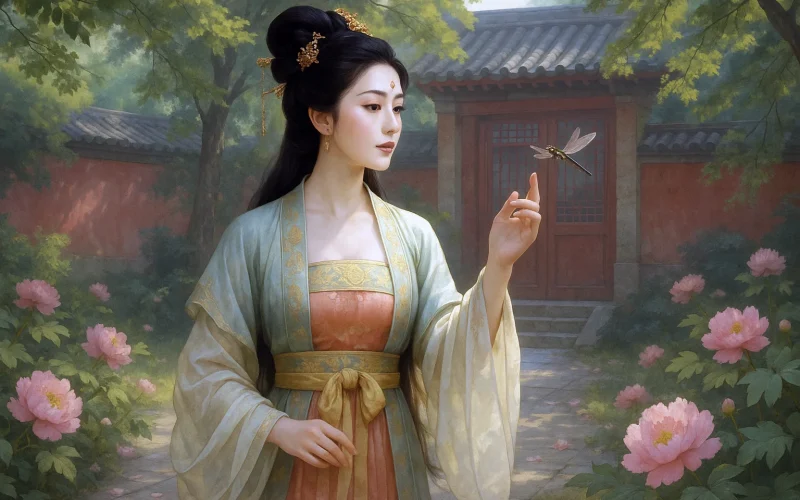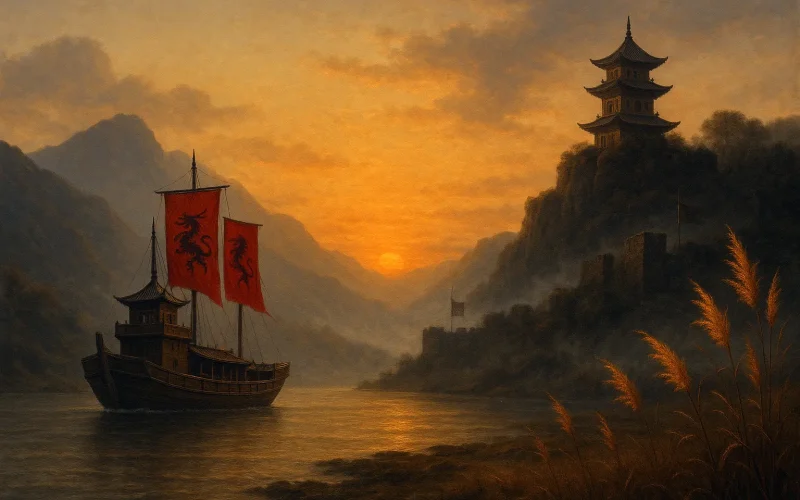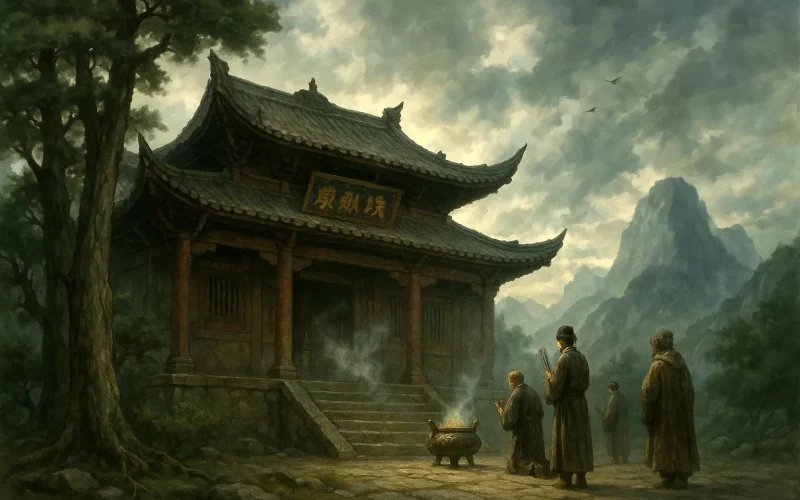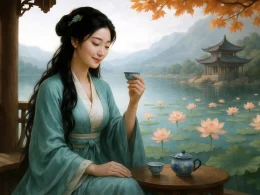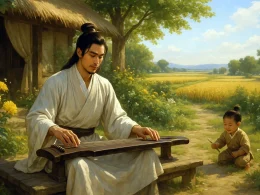In gala robes she comes down from her chamber
Into her courtyard, enclosure of spring...
When she tries from the centre to count the flowers,
On her hairpin of jade a dragon-fly poises.
Original Poem
「和乐天春词」
刘禹锡
新妆宜面下朱楼, 深锁春光一院愁。
行到中庭数花朵, 蜻蜓飞上玉搔头。
Interpretation
Composed during Liu Yuxi's poetic exchange with Bai Juyi, this work forms a dialogic counterpart to Bai's "Spring Lyrics" which depicted a young wife gazing wistfully from her chamber. While Bai captured her upstairs melancholy with subtle restraint, Liu's response portrays the same woman descending to admire spring scenery, offering complementary psychological insight. Their paired verses on spring longing not only demonstrate Tang literati's profound poetic camaraderie but also showcase the era's artistic pursuit of lyrical subtlety and emotional depth.
First Couplet: "新妆宜面下朱楼,深锁春光一院愁。"
Xīn zhuāng yí miàn xià zhū lóu, shēn suǒ chūnguāng yī yuàn chóu.
Fresh makeup bright, she descends vermilion tower / Though spring fills the courtyard, sorrow seals its flower
The heroine's meticulous adornment suggests hopeful anticipation, yet the vibrant springscape only amplifies her solitude. The paradoxical "locked-away springlight" juxtaposes visual splendor with emotional desolation, highlighting her unshared beauty.
Second Couplet: "行到中庭数花朵,蜻蜓飞上玉搔头。"
Xíng dào zhōng tíng shǔ huā duǒ, qīngtíng fēi shàng yù sāotóu.
Mid-garden she counts blooms one by one / A dragonfly alights on her jade hairpin undone
Attempting to dispel melancholy through flower-gazing, her absent-minded counting reveals profound wistfulness. The dragonfly's mistaken landing—confusing her adornment for actual blossoms—serves as both tribute to her floral beauty and metaphor for her predicament: admired yet isolated like courtyard peonies. This exquisite detail fuses human stillness with nature's dynamism, blending realism with symbolic resonance.
Holistic Appreciation
The poem captures a young wife's springtime melancholy through fragmented moments rather than explicit lament. "Fresh makeup," "vermilion tower," "blossoms," and "jade hairpin" construct layered imagery that reflects her posture, expression, and mood. Particularly masterful is the dragonfly's cameo—a fleeting intersection of human stillness and natural motion that lingers in the imagination. The work exemplifies how Tang poetry could distill profound emotion from mundane scenes through symbolic precision.
Artistic Merits
- Economical Imagery: Each carefully chosen detail ("counting flowers," "alighting dragonfly") carries psychological weight.
- Symbolic Juxtaposition: Contrasts between adornment/isolation, vibrancy/melancholy create emotional tension.
- Kinetic Stillness: The dragonfly's motion against the woman's frozen posture epitomizes the "dynamic stasis" technique.
- Suggestive Simplicity: Minimalist phrasing ("deep-locked springlight") implies complex emotional states.
Insights
Beyond portraying Tang feminine sensibility, the poem reveals a universal truth: even life's most radiant moments turn desolate without companionship. Liu Yuxi's genius lies in extracting profound loneliness from a seemingly pleasant scenario—the very beauty of spring intensifying the woman's isolation. This resonates deeply in modern contexts where curated social media "springscapes" often mask inner solitude. The work ultimately celebrates art's power to reveal emotional depths beneath surface appearances, reminding us that human connection, not external splendor, gives life its truest luster.
Poem translator
Kiang Kanghu
About the poet
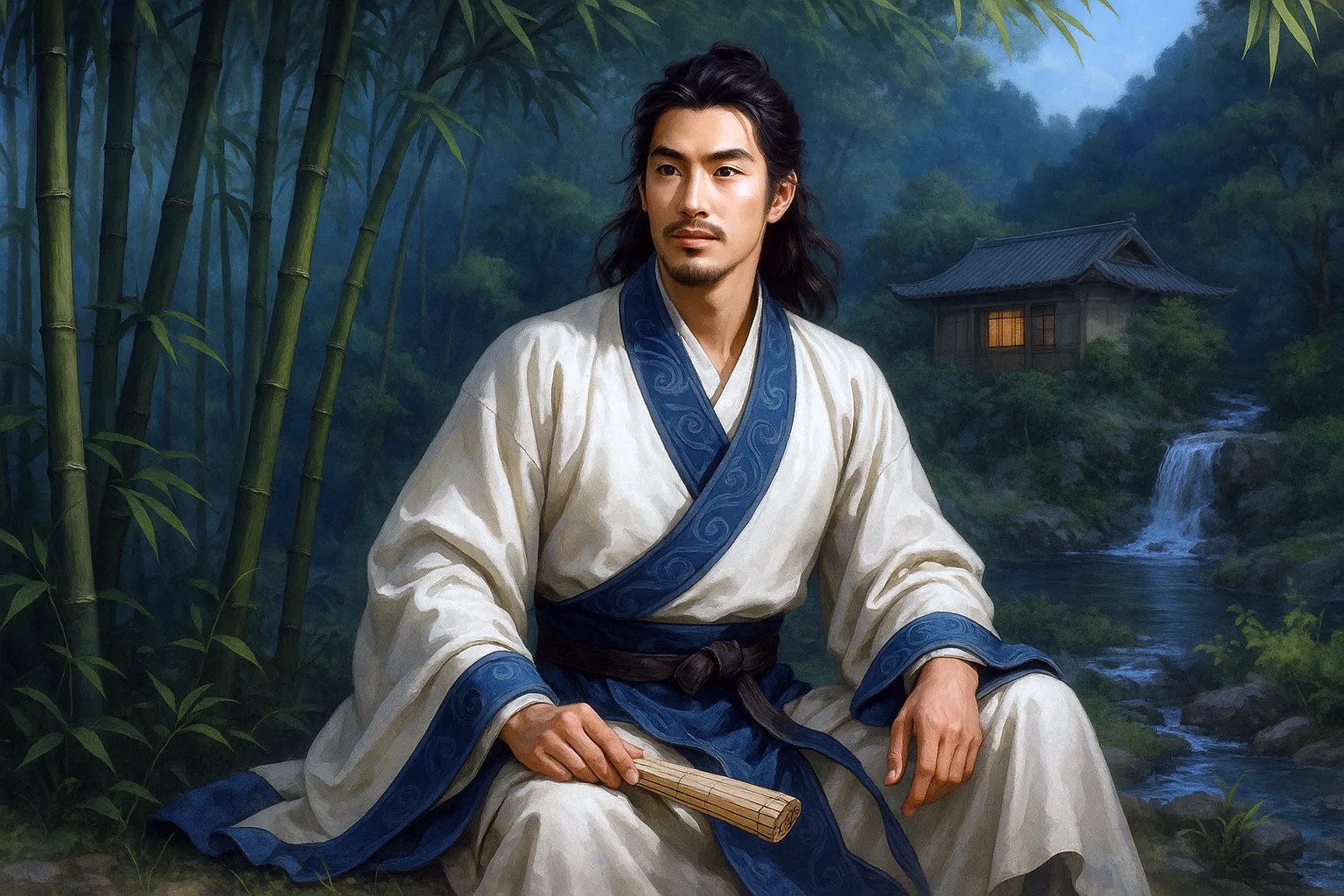
Liu Yuxi(刘禹锡), 772 - 842 AD, was a native of Hebei. He was a progressive statesman and thinker in the middle of the Tang Dynasty, and a poet with unique achievements in this period. In his compositions, there is no lack of poems reflecting current affairs and the plight of the people.






